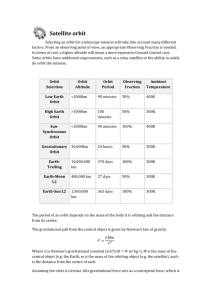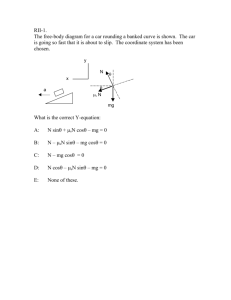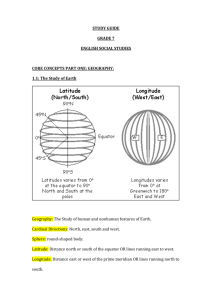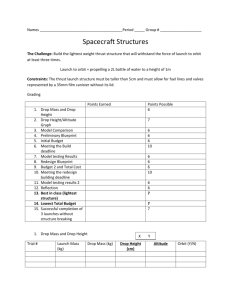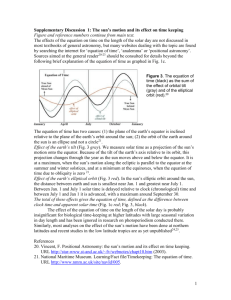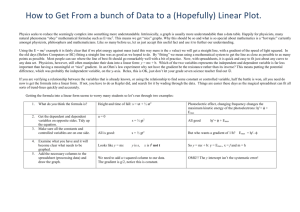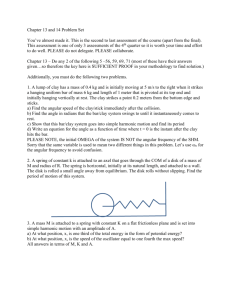A-5.2.2_Orbit_Variations_Brown
advertisement
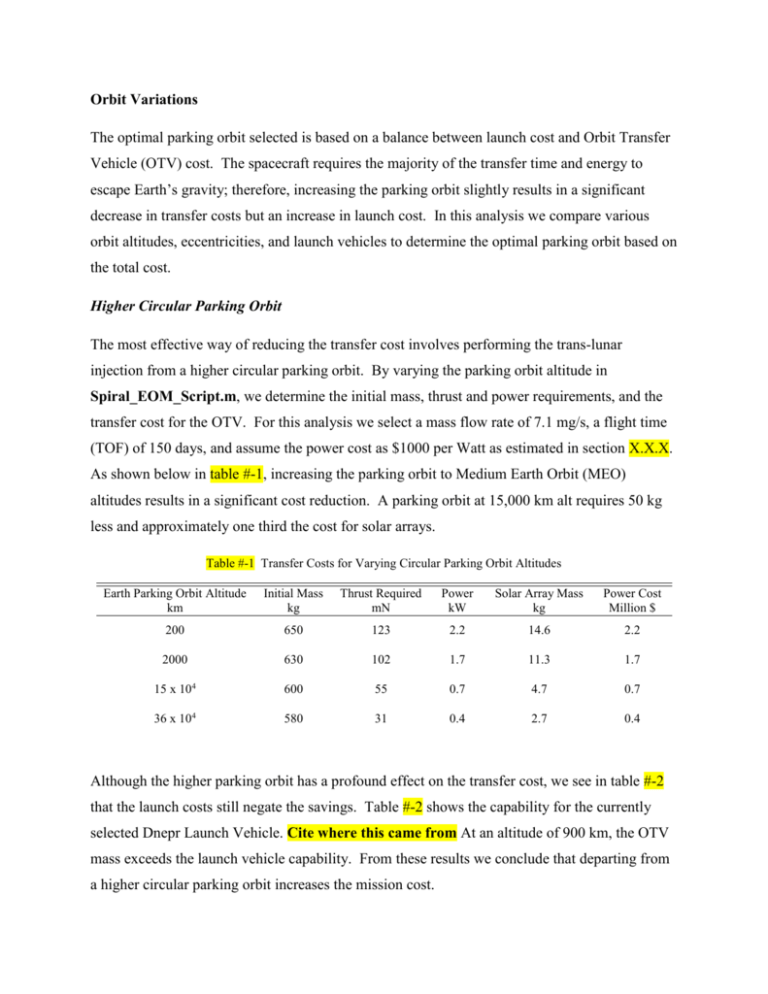
Orbit Variations The optimal parking orbit selected is based on a balance between launch cost and Orbit Transfer Vehicle (OTV) cost. The spacecraft requires the majority of the transfer time and energy to escape Earth’s gravity; therefore, increasing the parking orbit slightly results in a significant decrease in transfer costs but an increase in launch cost. In this analysis we compare various orbit altitudes, eccentricities, and launch vehicles to determine the optimal parking orbit based on the total cost. Higher Circular Parking Orbit The most effective way of reducing the transfer cost involves performing the trans-lunar injection from a higher circular parking orbit. By varying the parking orbit altitude in Spiral_EOM_Script.m, we determine the initial mass, thrust and power requirements, and the transfer cost for the OTV. For this analysis we select a mass flow rate of 7.1 mg/s, a flight time (TOF) of 150 days, and assume the power cost as $1000 per Watt as estimated in section X.X.X. As shown below in table #-1, increasing the parking orbit to Medium Earth Orbit (MEO) altitudes results in a significant cost reduction. A parking orbit at 15,000 km alt requires 50 kg less and approximately one third the cost for solar arrays. Table #-1 Transfer Costs for Varying Circular Parking Orbit Altitudes Earth Parking Orbit Altitude km Initial Mass kg Thrust Required mN Power kW Solar Array Mass kg Power Cost Million $ 200 650 123 2.2 14.6 2.2 2000 630 102 1.7 11.3 1.7 15 x 104 600 55 0.7 4.7 0.7 36 x 104 580 31 0.4 2.7 0.4 Although the higher parking orbit has a profound effect on the transfer cost, we see in table #-2 that the launch costs still negate the savings. Table #-2 shows the capability for the currently selected Dnepr Launch Vehicle. Cite where this came from At an altitude of 900 km, the OTV mass exceeds the launch vehicle capability. From these results we conclude that departing from a higher circular parking orbit increases the mission cost. Table #-2 Dnepr Launch Vehicle Capability Circular Altitude km 200 300 400 500 600 700 800 900 Deliverable Mass kg 4400 3700 3400 2750 1900 1200 650 300 Eccentric Orbits Although a high circular parking orbits does not reduce the mission cost, we consider departing from an eccentric parking orbit. We discover that performing trans-lunar injection from an orbit with a 400 km periapsis and 1000 km apoapsis still reduces the transfer cost compared to a 400 km circular orbit. For this analysis, we run Spiral_EOM_Script_Elliptic.m iteratively with EP_Sizing.m to determine the OTV initial mass and power necessary to achieve requirements. Assuming an engine mass flow rate of 5.6 mg/s, we size the OTV for six flight times between 351 and 196 days. For each flight time, the parking orbit apoapsis altitude varies between 400 to 10 x 104 km. (Periapsis is fixed at a 400 km altitude). This analysis results in 42 different flight scenarios. Because two engines with different flow rates are currently considered, we repeat this entire analysis for an engine mass flow rate of 7.1 mg/s. A sample of the results is provided in table #-3. Departure Orbit Variations.xlsx contains 12 tables similar to table #-3 for six flight times and two mass flow rates in the “Curve Fits sheet. Orbit Energy Plots The data from table #-2 specifies the launch capability to various circular orbits; however, it does not indicate how much mass can be launched into an elliptical orbit. Without knowing the deliverable mass to a particular elliptical orbit, we cannot determine the cost. To alleviate this problem, we calculate the amount of mass that can be delivered to an orbit of a specific energy. The orbit energy for a particular orbit can be found by eq. #-1 where μ is the gravitational parameter for Earth, and a is the semi major axis of the parking orbit. (eq. #-2) 𝜀=− 𝜇 2𝑎 (#-1) 𝑎 = 1⁄2 (𝑟𝑝 + 𝑟𝑎 ) (#-2) where rp and ra are the periapsis and apoapsis radii, respectively. As an example, table #-2 shows that 2750 kg can be delivered to a circular orbit at 500 km altitude. From eq. #-1 and #-2, we find that a 500 km circular orbit has energy of -28.97 km2/s2. Thus we assume that 2750 kg can be delivered to an orbit with energy of -28.97 km2/s2 regardless of the eccentricity. Manipulating eq. #-1 and #-2, an orbit of 400 km by 603 km has the same orbit energy. This shows that we can deliver the same mass of 2750 kg 103 km higher for the same launch cost. The data compiled in Departure Orbit Variations.xlsx indicates that an elliptical parking orbit reduces the cost, and the example above shows that it is possible to launch more mass to higher altitudes with eccentric orbits. For this reason we investigate the problem further. Implementing eq. #-1 and #-2, we take the data from Departure Orbit Variations.xlsx and relate it to orbit energy. See table #-3 below for the sample of this data. Table #-3 Sample of Sizing Results TOF days 286 Mass Flow Rate kg/s 5.6 Apoapsis Altitude km 400 500 750 1000 2000 5000 10000 Semi-major Axis km Orbit Energy Km2/s2 6778.14 -29.40 6828.14 6953.14 7078.14 7578.14 9078.14 11578.14 -29.19 -28.66 -28.16 -26.30 -21.95 -17.21 Power Cost Initial OTV Mass Million kg $ 649.6 649.4 649.0 648.6 646.8 643.1 639.3 Power Required kW 3.50 3.47 3.41 3.35 3.11 2.60 2.09 The 12 tables compiled in Departure Orbit Variations.xlsx contain 84 different flight scenarios. By plotting these data points, we develop linear relationships for how the initial OTV mass and power requirements vary. Figure #-1 displays the relationship of initial OTV mass with orbit energy. A different curve was created for the six flight times tested. As we see the initial OTV mass decreases as orbit energy increases. An increase in orbit energy corresponds to an increase in altitude, so this behavior is expected. We notice that shorter flight times result in a reduced mass. The engine operates at a constant mass flow rate, so the propellant mass can be found by eq #-3. Clearly shorter flight times result in reduced OTV mass. 𝑚𝑝𝑟𝑜𝑝 = 𝑚̇𝑡 (#-3) We also note that the amount of mass savings for different orbit energies varies with flight time. For a TOF of 351 days, the mass only decreases by about 8 kg between a 400 km circular and a 400 by 10 x 104 km orbit. The mass reduces approximately 21 kg for the same energy change when the flight time is 196 days. Thus as flight time decreases, we want to increase the departure altitude as much as possible. 690 680 670 660 TOF=351 650 TOF=316 640 TOF=286 630 TOF=256 620 TOF=226 610 TOF=196 600 590 -31 -29 -27 -25 -23 -21 -19 -17 -15 Orbit Energy (km^2/s^2) Fig. #-1 Initial OTV Mass as Function of Orbit Energy for mdot=5.6 mg/s Similar to fig. #-1, we create fig #-2 to display the relationship with the power required. The power required decreases as the orbit energy increases due to the reduction in thrust necessary to reach the Moon in the same amount of time. As the TOF decreases, the power requirements increase due to additional thrust needed. Similar to mass, the savings becomes more pronounced with shorter flight times. We create two similar plots for mass flow rates of 7.1 mg/s as well (See Departure Orbit Variations.xlsx). A mass flow rate of 7.1 mg/s results in larger propellant mass but reduced power requirements compard to 5.6 mg/s; however, the it is consistent with the relationships between orbit energy and TOF. 7 6 TOF=351 TOF=316 TOF=286 TOF=256 TOF=226 TOF=196 5 4 3 2 1 -31 -29 -27 -25 -23 -21 Orbit Energy (km^2/s^2) -19 -17 -15 Fig. #-2 Power Required as Function of Orbit Energy for mdot=5.6 mg/s We also create relationships for launch capability with orbit energy with LV Performance. Xlsx in the “Orbit Variations” sheet. In addition to the Dnepr, we include four other launch vehicles. See fig. #-3 below. 25000 20000 Dnepr 15000 Falcon 9 Delta IV 10000 Taurus Rockot 5000 0 -35 -33 -31 -29 -27 -25 Orbit Energy (km^2/s^2) -23 -21 Fig. #-3 Launch Capability as Function of Orbit Energy -19 -17 Although some of the launch vehicles cost more than the Dnepr (Falcon 9, Delta IV), they can provide significantly more mass to orbit. By including larger launch vehicles, we determine whether the increased capability, which corresponds to a reduction in cost per kilogram, offsets the additional purchase cost. Cost Comparisons With the results from the analysis above, we investigate the scenario that yields the lowest cost. Eq. #-4 displays a model for estimating mission cost. Although this model neglects several factors, it includes the major contributions to the cost. The total cost is found by adding the launch cost, power cost, and propellant cost. CLaunch_Vehicle represents the total launch vehicle cost. The ratio 𝐶𝐿𝑎𝑢𝑛𝑐ℎ_𝑉𝑒ℎ𝑖𝑐𝑙𝑒 𝑚𝑑𝑒𝑙𝑖𝑣𝑒𝑟𝑎𝑏𝑙𝑒 represents the cost per kilogram to a particular altitude. The product of the cost per kg and spacecraft mass (msc) yields the launch cost. Psc represents the power required for the spacecraft with Prate being the estimated $1000 per Watt. Lastly mprop represents the propellant required for the OTV with Xrate being the rate of Xenon ($1200 per kg). Cite this source 𝐶𝑡𝑜𝑡𝑎𝑙 = 𝑚𝑠𝑐 ∗ 𝐶𝐿𝑎𝑢𝑛𝑐ℎ_𝑉𝑒ℎ𝑖𝑐𝑙𝑒 𝑚𝑑𝑒𝑙𝑖𝑣𝑒𝑟𝑎𝑏𝑙𝑒 + 𝑃𝑠𝑐 ∗ 𝑃𝑟𝑎𝑡𝑒 + 𝑚𝑝𝑟𝑜𝑝 ∗ 𝑋𝑟𝑎𝑡𝑒 (#-4) We perform this analysis with Orbit_Altitude_Cost_Comparisons.m. As seen in table #-3, the orbit energies range between -29.4 and -17.2 km2/s2, so we find the total cost for hundreds of energy values in this range. Applying the curve fit equations from fig. #-3, we find the mdeliverable for each energy value. Similarly msc and Psc are found using the curve fit equations from figures #-1 and #-2. We indicate mprop from the data in Departure Orbit Variations.xlsx and CLaunch_Vehicle from cite this source. With all the conditions known, we calculate the total cost from eq. #-4. We repeat this analysis for all flight times and mass flow rates considered in Departure Orbit Variations.xlsx. With five launch vehicles and six flight times, we create 30 plots similar to figures #-4 and #-5, below. 9.5 mdot=5.6 mdot=7.1 9 Total cost (Million $) 8.5 8 7.5 7 6.5 6 5.5 5 0 2000 4000 6000 8000 Apoapsis Altitude (400 x ra) km 10000 12000 Fig. #-4 Total Cost with Varying Altitude for Falcon 9 at 351 day TOF 10 mdot=5.6 mdot=7.1 9.8 9.6 Total cost (Million $) 9.4 9.2 9 8.8 8.6 8.4 8.2 8 0 2000 4000 6000 8000 Apoapsis Altitude (400 x ra) km 10000 12000 Fig. #-5 Total Cost with Varying Altitude for Falcon 9 at 196 day TOF We see in fig. #-4 that the cheapest mission cost occurs at the lowest altitude of 400 km. The cost with a mass flow rate of 5.6 mg/s is consistently less than with 7.1 mg/s. Figure #-5 reveals that departing from a higher parking orbit does reduce the cost as compared to departing from a 400 km circular orbit. As mentioned above, the savings become more pronounced with shorter flight times, so the cost savings for the OTV mass and power requirements offset the increased cost of launching to a higher parking orbit. Because the power requirement savings become so prounced at shorter TOF, the engine operating at 7.1 mg/s is consistently cheaper than at 5.6 mg/s. The 30 plots created similar to fig. #-4 and #-5 show the results for a particular launch vehicle at a certain TOF. Running Orbit_Altitude_Cost_Comparisons.m, we determine the minimum cost for all vehicles analyzed and the TOF and altitude for which that occurs. 14 Delta 4 Falcon 9 Dnepr Rockot Taurus 13 Total cost (Million $) 12 11 10 9 8 7 6 5 399 399.5 400 400.5 Apoapsis Altitude (400 x ra) (km) 401 401.5 Fig. #-6 Minimum Total Cost for Each Launch Vehicle by Altitude We see in fig. #-6 that the overall minimum cost occurs for the Falcon 9 at approximately 5.3 million dollars. Dnepr has the next lowest cost at approximately 5.8 million dollars. For all launch vehicles, the minimum cost occurs when departing from a 400 km circular orbit. We seeing fig. #-7 that the minimum cost occurs at a flight time of 351 days. 14 Delta 4 Falcon 9 Dnepr Rockot Taurus 13 Total cost (Million $) 12 11 10 9 8 7 6 5 350 350.2 350.4 350.6 350.8 351 351.2 351.4 351.6 351.8 Time of Flight (days) 352 Fig. #-7 Minimum Total Cost for Each Launch Vehicle by Flight Time Forming Conclusions We see in this analysis that we can achieve the minimum cost by launching with the Falcon 9. At this time, the Falcon 9 has not yet launched; therefore, we cannot select it as our launch vehicle due to reliability issues. Based on cost we confirm our choice of launch vehicle to be the Dnepr. This analysis shows that in some cases launching to an eccentric orbit does reduce the total mission cost, particularly when flight times are shorter. As we see in fig. #-7, the minimum cost still occurs for longer flight times. Reaching the Moon in less time requires more thrust, which consequently requires more power. Even departing from higher parking orbits does not offset the cost of this additional power. If flight time was more of a limitation, this method would be practical. We have no constraints against a 351 day flight time; therefore we choose the longest flight time possible. The results show that for a 351 day flight time, the lowest parking orbit possible yields the minimum cost. Parking Orbit Selection Because the analysis in section X.X.X reveals that we must reach 400 km to negate drag effects, we choose to launch into a 400 km circular orbit with the Dnepr launch vehicle. Barring propulsion system constraints, we choose the flight time to be as long as possible.
